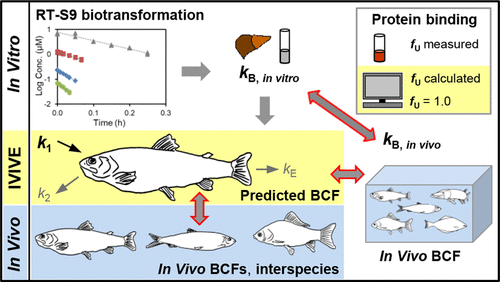当前位置:
X-MOL 学术
›
Environ. Sci. Technol.
›
论文详情
Our official English website, www.x-mol.net, welcomes your
feedback! (Note: you will need to create a separate account there.)
Examining Uncertainty in In Vitro-In Vivo Extrapolation Applied in Fish Bioconcentration Models.
Environmental Science & Technology ( IF 10.8 ) Pub Date : 2020-07-07 , DOI: 10.1021/acs.est.0c01492 Heike Laue 1 , Lu Hostettler 1 , Remo P Badertscher 1 , Karen J Jenner 2 , Gordon Sanders 3 , Jon A Arnot 4 , Andreas Natsch 1
Environmental Science & Technology ( IF 10.8 ) Pub Date : 2020-07-07 , DOI: 10.1021/acs.est.0c01492 Heike Laue 1 , Lu Hostettler 1 , Remo P Badertscher 1 , Karen J Jenner 2 , Gordon Sanders 3 , Jon A Arnot 4 , Andreas Natsch 1
Affiliation

|
In vitro biotransformation rates were determined for 30 chemicals, mostly fragrance ingredients, using trout liver S9 fractions (RT-S9) and incorporated into in vitro–in vivo extrapolation (IVIVE) models to predict bioconcentration factors (BCFs). Predicted BCFs were compared against empirical BCFs to explore potential major uncertainties involved in the in vitro methods and IVIVE models: (i) in vitro chemical test concentrations; (ii) different gill uptake rate constant calculations (k1); (iii) protein binding (different calculations and measurement of the fraction of unbound chemical, fU); (iv) species differences; and (v) extrahepatic biotransformation. Predicted BCFs were within 0.5 log units for 44% of the chemicals compared to empirical BCFs, whereas 56% were overpredicted by >0.5 log units. This trend of overprediction was reduced by alternative k1 calculations to 32% of chemicals being overpredicted. Moreover, hepatic in vitro rates scaled to whole body biotransformation rates (kB) were compared against in vivo kB estimates. In vivo kB was underestimated for 79% of the chemicals. Neither lowering the test concentration, nor incorporation of new measured fU values, nor species matching avoided the tendency to overpredict BCFs indicating that further improvements to the IVIVE models are needed or extrahepatic biotransformation plays an underestimated role.
中文翻译:

在鱼类生物富集模型中应用体内外推法检查不确定性。
使用鳟鱼肝S9馏分(RT-S9)确定了30种化学物质(主要是香料成分)的体外生物转化率,并结合到体外-体内外推(IVIVE)模型中以预测生物富集因子(BCF)。将预测的BCF与经验BCF进行比较,以探索参与体外方法和IVIVE模型的潜在主要不确定性:(i)体外化学测试浓度;(ii)不同的g吸收率常数计算(k 1);(iii)蛋白质结合(未结合的化学成分f U的不同计算和测量); (iv)物种差异;(v)肝外生物转化。与经验性BCF相比,44%的化学品的预测BCF在0.5 log单位以内,而超过0.5 log单位的56%则被过度预测。通过替代性k 1计算,这种过度预测的趋势减少了32%的化学品被过度预测。此外,将比例为全身生物转化率(k B)的体外肝移植速度与体内k B估计值进行了比较。体内k B被低估了79%的化学物质。既不降低测试浓度,也不引入新的测得的f U 值和物种匹配都避免了过度预测BCF的趋势,这表明需要进一步改进IVIVE模型,或者肝外生物转化的作用被低估了。
更新日期:2020-08-04
中文翻译:

在鱼类生物富集模型中应用体内外推法检查不确定性。
使用鳟鱼肝S9馏分(RT-S9)确定了30种化学物质(主要是香料成分)的体外生物转化率,并结合到体外-体内外推(IVIVE)模型中以预测生物富集因子(BCF)。将预测的BCF与经验BCF进行比较,以探索参与体外方法和IVIVE模型的潜在主要不确定性:(i)体外化学测试浓度;(ii)不同的g吸收率常数计算(k 1);(iii)蛋白质结合(未结合的化学成分f U的不同计算和测量); (iv)物种差异;(v)肝外生物转化。与经验性BCF相比,44%的化学品的预测BCF在0.5 log单位以内,而超过0.5 log单位的56%则被过度预测。通过替代性k 1计算,这种过度预测的趋势减少了32%的化学品被过度预测。此外,将比例为全身生物转化率(k B)的体外肝移植速度与体内k B估计值进行了比较。体内k B被低估了79%的化学物质。既不降低测试浓度,也不引入新的测得的f U 值和物种匹配都避免了过度预测BCF的趋势,这表明需要进一步改进IVIVE模型,或者肝外生物转化的作用被低估了。






























 京公网安备 11010802027423号
京公网安备 11010802027423号